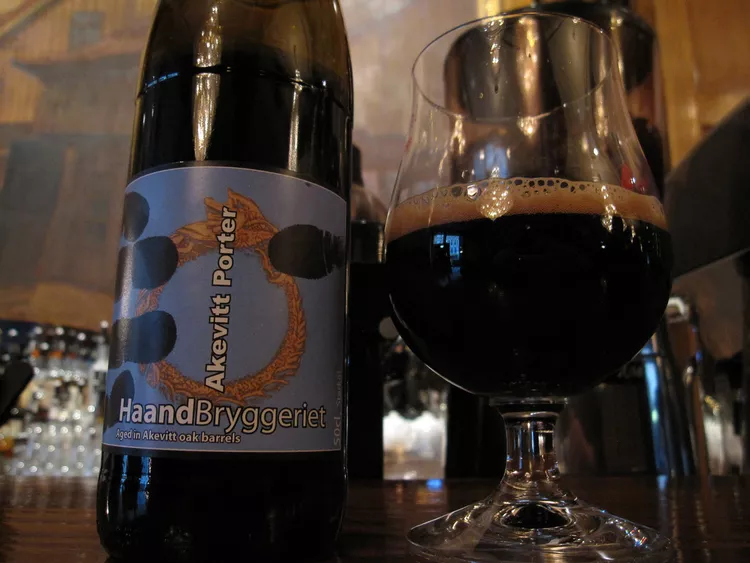Summary of Norwegian Alcoholic Beverages
Beer, wine, and spirits add Skal to festive gatherings.
Norwegians enjoy a robust pub culture and a burgeoning culinary scene, especially in the larger cities of Oslo, Bergen, Trondheim, and Tromsø. They began brewing beer 3,000 years ago, and modern Norwegians continue this tradition with both traditional lagers and innovative craft brews. The recent interest in wine has led to an increase in imports from their southern grape-growing neighbors in Italy, France, and Spain.
While the heavily regulated Norwegian alcohol industry relaxed some restrictions during the early 2000s, prices for alcoholic beverages throughout Norway remain high. Furthermore, a near-zero tolerance policy makes consuming even one adult beverage before driving a risky proposition. However, Norway’s efficient public transportation system allows you to join the locals in raising a toast without worry.
Akevitt
Norwegians started distilling akevitt, also known as aquavit, in the 1500s. Common throughout Scandinavia, akevitt resembles gin, with the dominant flavor of caraway instead of juniper. This neutral spirit, derived from potatoes or grain, may also include spices such as fennel, cumin, or cardamom, along with citrus zest.
The beverage’s golden hue can vary from clear to light brown, depending on the vintage. Norway’s famous Linie Aquavit undergoes a unique aging process, being shipped to Australia and back. Furthermore, Scandinavians traditionally consume akevitt, ideally in tulip-shaped glasses, during festive gatherings like Christmas, New Year’s Eve, and weddings.
Mead (mjød)

Mead holds an important place in many Scandinavian celebrations dating back to Viking times, such as Midsummer festivals. In winter, Norwegians often enjoy it hot, paired with ginger biscuits. The majority of the drink’s fermented sugar comes from honey, earning it the popular nickname “honey wine.”
Gløgg

The traditional Scandinavian mulled wine known as gløgg combines aquavit with red wine simmered with cloves and cinnamon, producing a subtly sweet yet potent drink best served hot. Norwegians typically enjoy gløgg during winter, particularly around Christmas, often accompanied by a spoon for scooping out the raisins and almonds added to the glass.
Punsch

Punsch was introduced to Scandinavia from Java, Indonesia, by Dutch traders in the 18th century. The name “punsch” derives from the Hindi word for five, referring to the five ingredients that compose this beverage: alcohol, water, sugar, fruit, and spices.
Originally based on arrack, a Southeast Asian distilled spirit, Norwegian punsch may be flavored with liqueur, adding characteristic notes of almond, chocolate, and banana. Similar to many adult beverages in Norway, where around a third of the country lies within the Arctic Circle, punsch is served hot during the winter months.
Brennivin

Although Brennivin is more commonly associated with Iceland, it can be found throughout Scandinavia. Translating to “burn-wine,” Brennivin is technically a type of aquavit and most closely resembles a strong brandy, with an alcohol content ranging from 30 to 38 percent.
Beer

Beer production in Norway dates back 3,000 years, but most pubs predominantly served lager until the early 2000s. Popular Norwegian beer styles include Pilsner, a pale golden lager with a distinctive hoppy flavor; Bayer, a dark malt lager with a sweet flavor; and stronger lagers such as juleøl and bokko. In recent years, the craft beer scene has blossomed, featuring a variety of international styles and numerous thriving microbreweries.
Cider

In Norway, apple cider can be served chilled or hot and, in some regions, is referred to as apple wine. Its golden hue varies from light to dark based on the preparation process and ingredients. Visitors can explore the Hardangerfjord region, where English monks introduced apples to locals in the 13th century, and where 40 percent of the country’s fruit trees now thrive.
Vodka

Vikingfjord, a well-known brand of Norwegian vodka distilled from water sourced from the Jostedalsbreen glacier, won a gold medal at the international Wine and Spirit competition in London in 2016. It is a popular choice in Norway and is now available in stores across the globe, coming in both plain and flavored varieties with an alcohol content of 40 percent.
Wine

Norway boasts the northernmost commercial vineyard in the world, Lerkekåsa Vineyard located in Gvarv, yet it produces only a small fraction of the wine it consumes. Most wines served in restaurants are imported from France, Italy, and Spain, while the country’s Vinmonopolet (Wine Monopoly) chain is the sole retailer authorized to sell bottled wine and offers a more extensive selection from around the globe.
Fruit Beer

In Norway, fruit beers brewed with Arctic crowberries, which are reminiscent of a cross between blackberries and blueberries, are popular. These beers are often infused with various herbs and spices, with additional flavors such as cherry, raspberry, and peach. Many brewers craft these beverages in the slightly sour lambic style, offering a unique taste experience.





